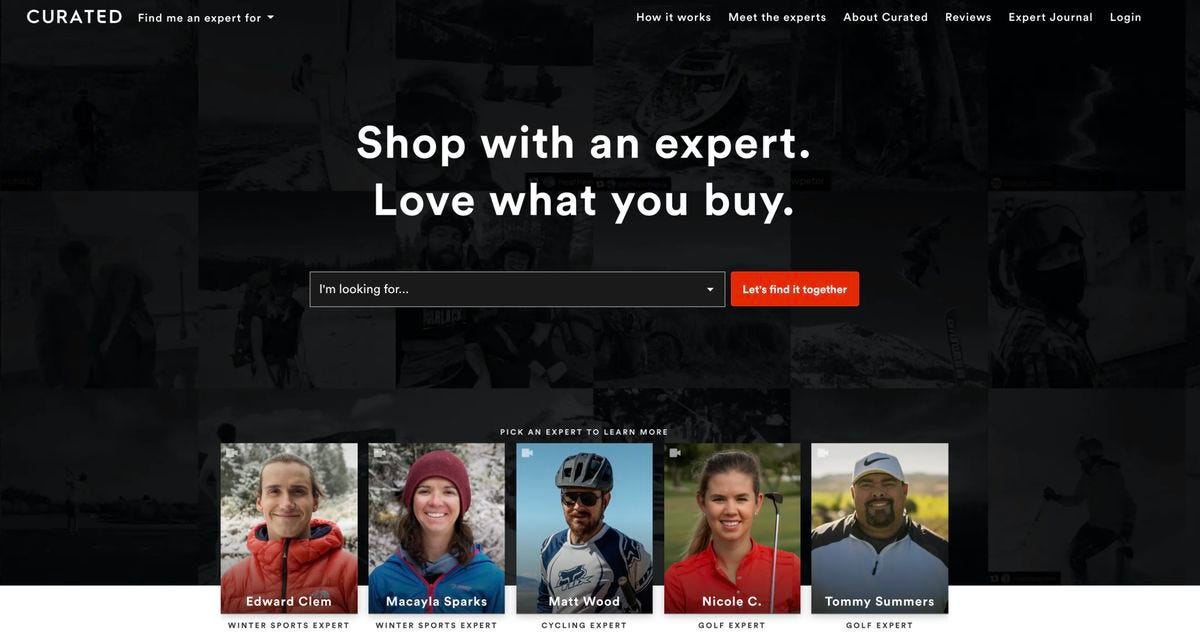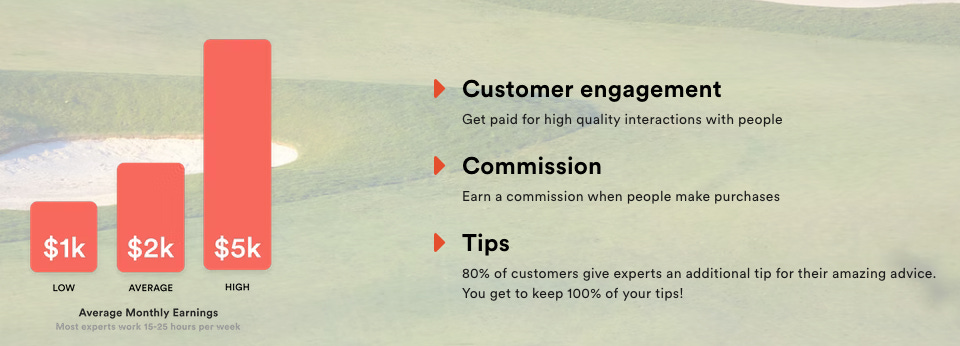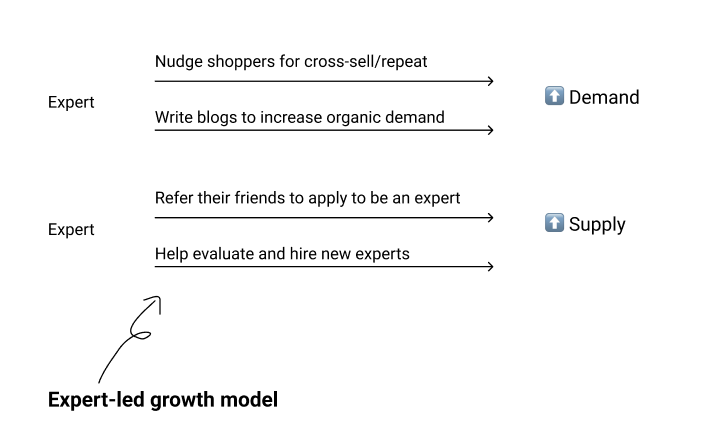🏌️Curated
By: Leo Luo from Consumer Strartups
One of my biggest personal theses is that more and more people will be able to make money from doing things they love.
According to a Zapier report, one in three Americans has a side hustle and one in four Americans plans to start one. It also states that while passive income is the primary reason why people start a side hustle, passion is the close second - almost 40% say they started the side hustle to pursue something they enjoy doing.
The side hustle boom is also intersecting with the rise of the creator economy. As creator economy platforms and tools continue to blossom, the barriers to becoming a creator or a micro-entrepreneur decreased drastically. In the past two years, I have had the opportunity to cover quite a few startups in the space.
Here is a few of them:
Pallet helps creators/community builders to make money by organizing job boards
Beacons helps creators easily build a link-in-bio website
Sunroom makes it better for women and non-binary creators to monetize their content in a safe way
Cameo allows any influencers, big or small, to monetize their fame
Boomy makes it easy to create music using AI and monetize from them
Cakeshop (formerly Apothecary) allows skincare creators to easily build their own skin shop
The star of today’s newsletter is Curated. Curated empowers experts/enthusiasts to make money from talking about their biggest passions and helps shoppers to make the right purchase with the guidance of a domain expert.
It’s on track to do $100M+ in revenue this year and has raised from top investors like Capital G, Forerunner Ventures, Greylock, and many more. I got the opportunity to interview Eduardo Vivas about his story building Curated.
Wondering how Curated is leveraging the supply-side to amplify its growth flywheel? Keep reading to find out.
The concept of a guided shopping experience is not novel. In the offline world, shopping has always been a collaborative, guided experience, especially for items that tend to be more expensive, such as outdoor sports gear and luxury apparel.
In the digital world, it’s also not entirely new. A decade ago, a company called Hunch used machine learning and predictive modeling to recommend products to its users based on different signals around the web. It was eventually sold to eBay in 2011. In recent years, the concept of buying personalized products has become quite popular. Many online consumer brands, such as Prose, are personalizing their product offerings to consumers based on a survey the consumer fills out prior to the purchase.
Nevertheless, none of them could provide a high-touch shopping experience online that would help consumers to make a purchase with a human expert. It’s hard to scale a quality expert network, and it is also challenging to achieve favorable unit economics for an e-commerce platform if you have to subsidize the expert side. However, Curated figured them out.
Genesis of Curated
Eduardo Vivas, the CEO and Co-founder of Curated, is no stranger to building marketplaces and creating scalable companies. Prior to founding Curated, he built Bright.com, an AI-powered platform to connect job seekers with relevant employers. He sold Bright.com to LinkedIn for the tune of $120M, and for the subsequent few years, Eduardo led the product and strategy teams for LinkedIn’s Talent Solutions business.
Eduardo got the idea for Curated from a skiing trip to Colorado. As a beginner, Eduardo rushed into buying the highest-rated luxury gear thinking that he couldn’t go wrong with that option. However, the fancy gear made it challenging and he struggled every time he skied. After a while, he decided to consult with a snowboarding instructor. Eduardo quickly learned that he needed cheaper boards and boots that were more suitable for his level. He wished he had been able to get some unbiased expert advice before spending thousands of dollars. This trip was an aha moment for Eduardo.
In 2017, He recruited a few of his LinkedIn buddies and started building Curated to help consumers make the best purchase online with the help of a human expert.
Product journey and idea validation
MVP
The team's first attempt at the problem was to connect shoppers with retailers. The idea was that retailers had experts that could help with online shoppers on Curated. However, they quickly pivoted away from this initial positioning due to a couple of key realizations:
Retailers don’t have excess labor on hand. People who work at retailers are busy at their own stores and are unlikely to be able to address customer requests promptly for Curated
There is a business model difference - Curated is using a commission-based model while most people at retailers are not commission-based and might not be incentivized enough to jump on the customer requests
To make it work, they had to hire experts themselves.
Demand testing
Before building out the full-fledged platform, Eduardo and his team wanted to make sure there is enough demand for being an expert and shopping with an expert online.
On the expert side - the Curated team posted ads about their platform on Craigslist about hiring experts and they got inundated with inquiries and many people asked if the job postings were fake. It was very clear from the beginning that many people are very interested in the idea of making money from just chatting about their passions.
On the consumer side - they launched the Curated website with a simple 10-question questionnaire and marketed it online to see how many people would fill it out and give out their phone numbers. The team validated there was solid demand, and most importantly, that as long as the questions were relevant, they could collect user intention data at a relatively low cost.
These two experiments provided the team with the confidence to invest more into this idea.
Sign of PMF
After validating interest from both shoppers and experts, Eduardo and his team went out to hire experts themselves and launched the V1 platform. They knew they were onto something when a ton of customers reached out during the early days and asked how they could tip the experts after a purchase, which is not common for a retail experience.
The economics of the business
Business model
Curated uses an “expert-assisted” retail model. The company buys products at wholesale prices from brand partners and sells them to customers at retail prices. They have their own warehouse to fulfill orders. On the front end, experts curate the products and recommend the relevant ones to shoppers. To ensure unbiased advice, experts are free to promote any product that they would like. If a product recommended by the expert is not on the platform, Curated will send customers to a partner retailer or help customers buy the product from a third party directly.
This expert-assisted business model works for a few reasons:
High AOV - Categories on Curated (e.g. outdoor sports) tend to have a high average order value at around $700
Expert increases customer conversion rate - with the help of an expert, the consumer is way more likely to convert and feel comfortable placing a big order
Consumers cover half of the expert cost through tips - almost 80% of consumer tips, which account for 45% of an expert’s compensation
Low return rate - since consumers get the most suitable products recommended by experts, the return rate is only between 1-2.5%, which is a lot less than the industry average of 15-30%, according to CBRE
Even though they have to pay experts for each product they sell, Curated is still able to have favorable economics due to high AOV, high conversion rate, high tipping rate, and low return rate.
Expert economics
Expert experience is a key north star for Curated. To ensure the entire experience works, the platform has to make sure that experts are happy and continue to feel motivated to serve their customers.
There are two main drivers for why an expert takes this gig - passion and compensation. Passion is something that is intrinsic to this model. Experts on the platform love what they are promoting and they enjoy sharing with other people. However, most experts are employed elsewhere and are busy so it is important to provide a strong financial incentive to get experts excited about providing a good experience for each and every shopper.
There are three types of income sources for experts:
Customer engagement (10% of comp) - you get paid for having a quality conversation with a lead (e.g. $1 after 5 back-and-forth texts with a customer)
Tips (45% of comp) - most customers leave a tip after buying from Curated and 100% of the tip goes to the expert
Commission (45% of comp) - get a fixed commission based on the sale, usually ranging in the high single-digit
The average income per month will likely vary depending on the expert and the category. Based on Curated’s website, for an average month, an expert that works 15-25 hours per week can make anywhere from $1K to $5K. Also, a skiing expert that recommends skiing gears will likely make more than experts that recommend tennis racquets since the average order value of the skiing category tends to be bigger than that of the tennis category.
Growth Frameworks
Category expansion framework
One of Curated’s biggest growth levers is category expansion.
One way to look at category expansion is growth within the existing categories. Curated currently focuses on outdoor sports, covering eight different categories from snowboarding to tennis.
For example, in just the camping and hiking category alone, Curated has 11 subcategories, which also has another 5-10 sub-categories within. Since the market size of the eight existing outdoor sports categories is already large, the team can continue to grow by expanding to more subcategories and partnering with more brands to capture even broader customer segments. The hiking gear and equipment market alone was estimated to be $5.8B in 2020. Not surprisingly, Curated has been able to grow 100%+ year over year in its existing categories.
Besides expanding within existing categories, Curated is also expanding to new categories. There are three main factors that the team looks at when evaluating a new category - unit economics, the size of the passionate fanbase, and cross-selling potential.
Unit economics - specifically, the average order value for the category. Since the expert takes a fixed percentage commission per order, it is important to choose a category with many high price items so both experts and the company can have a healthy margin for each transaction. According to Eduardo, the average order value across categories is around $700 and any category with less than $300 would be tough for the unit economics
Size of the passionate fanbase - to make sure there are enough experts that could support each new category, it is important that the category has many active enthusiasts who love sharing their knowledge and are already actively engaging in their niche communities on platforms like Reddit
Cross-selling potential - a new category should ideally attract similar customer profiles as those of existing categories. It would be a lot easier to cross-sell to the same user base which is especially helpful for turbo-boosting the demand for a new category.
This systematic approach of both growing within existing categories and expanding to new ones has been pivotal for Curated’s rapid growth.
Expert-led growth model
A unique part of Curated’s growth story is its expert-led growth model. Experts help grow the company on both the demand side and expert supply side.
On the demand side, experts own the relationship with the shopper so not only can it help the shopper to place their first order, but they can also encourage repeat purchases or even cross-sell the shopper by introducing them to other categories.
Additionally, experts also play a huge part in SEO and content marketing. Curated has a page called Expert Journal and many experts from all categories contribute to the posts. This expert-led content marketing approach is a scalable way to create authentic content that can be helpful for both prospective shoppers and SEO domain ranking.
On the supply side, experts also play the main role in recruiting other shoppers. Curated has a social hiring model. The principle is that experts know who are the other experts the best. Existing experts often refer their other expert friends to join the platform and they also play a big role in evaluating and interviewing the potential experts. This expert-led hiring model allows Curated to quickly identify and acquire the right experts at scale.
Leveraging the supply side to increase both the supply and demand can be a great growth framework for many marketplace startups.
Closing thoughts
Curated has raised over $140M from VCs to date and it is on its way to reaching 9-digit revenue this year. For Eduardo, this is just the beginning and he has a big vision for the company. Here is a snippet from his interview with Harry Stebbings from 20 Mins VC.
“We want to be the go-to place for all expert advice and help as many experts as possible to monetize their passion. Hopefully, it’s not just about helping you buy things. We sold you ski gear and we can help you with your next ski trip. We sold your coffee makers and we can also teach you how to make your first cup of coffee. The fact we have live humans in the loop means you can do so many things that haven't been done in the past.” - Eduardo Vivas
That’s it for this week!
See you soon 👋,
Leo




